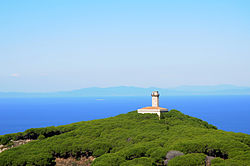Isola del Giglio
Isola del Giglio | |
|---|---|
| Comune di Isola del Giglio | |
 Old Lighthouse on the north of the island | |
UTC+2 (CEST) | |
| Postal code | 58010, 58012, 58013 |
| Dialing code | 0564 |
| Patron saint | San Mamiliano |
| Saint day | September 15 |
| Website | Official website |

Isola del Giglio (Italian pronunciation:
In 2012, the cruise ship Costa Concordia foundered off the coast of the island.
Geography
The island is separated by a 16 km (10 mi) stretch of sea from the nearest point of the mainland, the promontory of Monte Argentario. Mainly mountainous, it consists almost entirely of granite, culminating in the Poggio della Pagana, which rises to 496 m (1,627 ft). Ninety percent of its surface is covered by Mediterranean vegetation, alternating with large pine forests and numerous vineyards which allow the production of the local "Ansonaco" wine. The coast is 27 km (17 mi) long, made up of rocks, smooth cliffs and several bays: Arenella, Cannelle, Caldane and Campese, the biggest one with its small village of the same name.
The municipality is composed of the islands of Giglio and Giannutri. Three principal settlements are located on the main island:
- Giglio Porto (G. Harbour), located on the eastern coastal side and hosts the port. It is divided into the quarters of Chiesa, Moletto and Saraceno.
- Giglio Castello (G. Castle), located upon a hill between the two other localities and characterized by the majestic walls of a fortress. It is divided into the quarters of Casamatta, Centro, Cisterna and Rocca.[4]
- Giglio Campese, it is located on the north-western coastal side and is a modern sea resort.
History
The modern island was formed probably 4.5 to 5 million years ago, and has been inhabited since the
In 805, the island was donated by
On 14 June 1646, Grand Admiral
In July 2020, the island attracted global attention because it had not yet experienced any known cases of COVID-19.[12]
Alongside its history, the island was always renowned for its mineral ore: many columns and buildings in Rome were built with the Gigliese granite.
Government
List of mayors
| Mayor | Term start | Term end | Party |
|---|---|---|---|
| Giacomo Landini | 1995 | 2004 | National Alliance |
| Attilio Brothel | 2004 | 2009 | Civic
|
| Sergio Ortelli | 2009 | Incumbent | Civic
|
Main sights


The island houses the remains of a Roman villa of Domitius Ahenobarbus (1st-2nd century AD), in the area of Giglio Porto (Giglio port). No traces of the once existing Temple of Diana can be seen now. The church of San Pietro Apostolo in Giglio Castello (Giglio castle) has an ivory crucifix attributed to the sculptor Giambologna.
The island is also the site of an Etruscan shipwreck dating back to the early Iron Age, c. 600 BC.[13] The cargo of the ship included copper and lead ingots, iron spits, amphorae and a Corinthian helmet. Even a wooden writing tablet with stylus was preserved. The finds are almost completely lost now.
Transportation
Isola del Giglio is connected to Tuscany by ferries run by the shipping companies Toremar and Maregiglio, departing daily from Porto Santo Stefano.
Costa Concordia grounding incident

In 2012, the island received prolonged international media attention, following the 13 January 2012 running aground of the cruise liner Costa Concordia, just off the island's shore. Most of the more than 4,200 passengers and crew were rescued and taken to the island, as well as to the mainland. 32 people died and 64 were injured. The people of the island rushed to help, providing hot drinks and blankets, and many opened their homes to the victims. The arrival of 2,000 salvage workers invigorated life on the island, and many of the workers fraternised with the islanders. Some local women left the island with their new partners.[citation needed]
The ship removal work was started in 2013 and was completed towards the end of July 2014. Flotation devices were attached to right the ship and then raised it. It was subsequently towed to its final destination port of Genoa to be scrapped.[14][15]
In popular fiction
In the 2007 romantic bestselling Italian novel Scusa ma ti chiamo amore by Federico Moccia, the couple end up living in a lighthouse on this island.
It is also the site of the
Sister cities
 Italy, San Quirico d'Orcia since 2013
Italy, San Quirico d'Orcia since 2013
See also
References
- ^ "Superficie di Comuni Province e Regioni italiane al 9 ottobre 2011". Italian National Institute of Statistics. Retrieved 16 March 2019.
- ^ "Popolazione Residente al 1° Gennaio 2018". Italian National Institute of Statistics. Retrieved 16 March 2019.
- ^ Pliny the Elder, Natural History III.81
- ^ "Giglio Castello". Tourist Association Pro Loco Isola del Giglio and Giannutri "G. Bancalà". Archived from the original on 1 October 2013. Retrieved 22 January 2012.
- ^ Princeton Encyclopedia of Classical Sites: "Aegilium Insula"
- ^ Christoph Cellarius, Notitia orbis antiqui: sive geographia plenior, 1701-06:606.
- ^ De Bello Civili, book I, ch. xxxiv.
- ^ Hist. Nat. III.12.
- ^ Mela, book ii, ch. cvii.
- ^ Namatianus, Rutilius Claudius (1907). Charles H. Keene (ed.). Rutilii Claudii Namatiani De Reditu Suo Libri Duo: The Home-Coming of Rutilius Claudius Namatianus from Rome to Gaul in the Year 416 A.D. Trans. George F. Savage-Armstrong. London: G. Bell. pp. 134–137.
Quam fraudare nefas laudis honore suae.
- ^ Chisholm, Hugh, ed. (1911). . Encyclopædia Britannica. Vol. 12 (11th ed.). Cambridge University Press. pp. 5–6.
- ^ Miles, Frank (2020-07-26). "Italy's Giglio Island sees zero residents with coronavirus: 'Nobody is sick'". Fox News. Retrieved 2020-07-27.
- ^ Lienhard, John H. "An Etruscan Wreck". The Engines of Our Ingenuity. University of Houston. Retrieved 22 January 2012.
- ^ (in Italian) "Summary of the presentation of removal project" Archived 2012-07-12 at the Wayback Machine (Giglio News)
- Rai News24)


